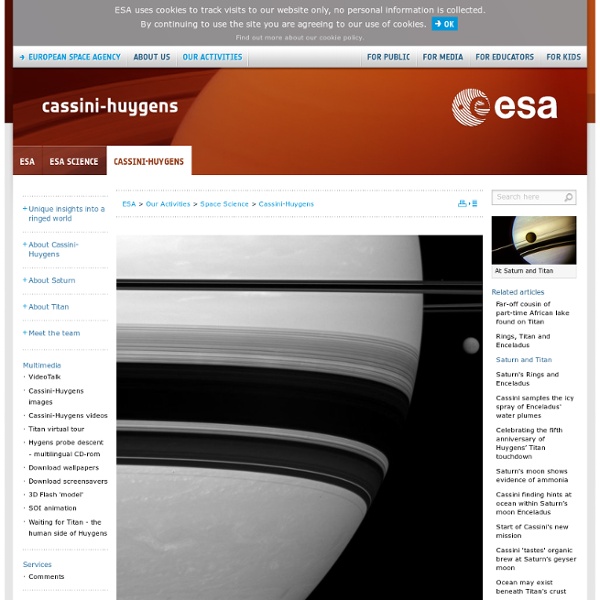About Saturn & Its Moons
Introduction On June 30, 2004, the Cassini spacecraft entered orbit around Saturn to begin the first in-depth, up-close study of the ringed planet and its domain. As expected, the Saturn System has provided an incredible wealth of opportunities for exploration and discovery. "We're looking at a string of remarkable discoveries -- about Saturn's magnificent rings, its amazing moons, its dynamic magnetosphere and about Titan's surface and atmosphere," says Dr. Cassini's observations of Saturn's largest moon, Titan, have given scientists a glimpse of what Earth might have been like before life evolved. The spray of icy particles from the surface jets collectively forms a towering plume three times taller than the width of Enceladus. The first four years of the Cassini-Huygens saga brought a new dimension of understanding of the complex and diverse Saturn system. Why the "Cassini Solstice Mission?" A complete seasonal period on Saturn has never been studied at this level of detail.
Saturn: Moons
Saturn, the sixth planet from the sun, is home to a vast array of intriguing and unique worlds. From the cloud-shrouded surface of Titan to crater-riddled Phoebe, each of Saturn's moons tells another piece of the story surrounding the Saturn system. Christiaan Huygens discovered the first known moon of Saturn. The year was 1655 and the moon was Titan. As telescopic resolving power increased through the 19th century, Saturn's family of known moons grew. We've discovered a total of 53 natural satellites orbiting Saturn. Here's a sampling of some of the unique aspects of the moons: - Titan is so large that it affects the orbits of other near-by moons. - Iapetus has one side as bright as snow and one side as dark as black velvet, with a huge ridge running around most of its dark-side equator. - Phoebe orbits the planet in a direction opposite that of Saturn's larger moons, as do several of the more recently discovered moons. References:
Saturn's Moons
Saturn's Moons The dozens of icy moons orbiting Saturn vary drastically in shape, size, surface age and origin. Some of these worlds have hard, rough surfaces, while others are porous bodies coated in a fine blanket of icy particles. All have greater or smaller numbers of craters, and many have ridges and valleys. Some, like Dione and Tethys, show evidence of tectonic activity, where forces from within ripped apart their surfaces. Many, like Rhea and Tethys, appear to have formed billions of years ago, while others, like Janus and Epimetheus, could have originally been part of larger bodies that broke up. To date, 53 moons have been officially named. Astronomers continue to find new small moons orbiting Saturn, using both ground-based observatories and Cassini's own imaging cameras. For more information on the latest moons discovered visit the Recent Discoveries page and the Icy Satellites publications listing. Diversity of Worlds The moons of Saturn are a diverse collection.
Moons of Saturn
Artist's concepts of the Saturnian ring–moon system Saturn, its rings and major icy moons—from Mimas to Rhea Images of several moons of Saturn. The rings of Saturn are made up of objects ranging in size from microscopic to moonlets hundreds of meters across, each in its own orbit about the planet.[7] Thus a precise number of Saturnian moons cannot be given, as there is no objective boundary between the countless small anonymous objects that form Saturn's ring system and the larger objects that have been named as moons. Discovery and naming[edit] Early observations[edit] Observations by spacecraft[edit] Four moons of Saturn can be seen on this image by the Cassini spacecraft: Huge Titan and Dione at the bottom, small Prometheus (under the rings) and tiny Telesto above center. Five moons in another Cassini image: Rhea bisected in the foreground, Mimas behind it, bright Enceladus above and beyond the rings, Pandora eclipsed by the F Ring, and Janus off to the left. Outer moons[edit] Naming[edit]



